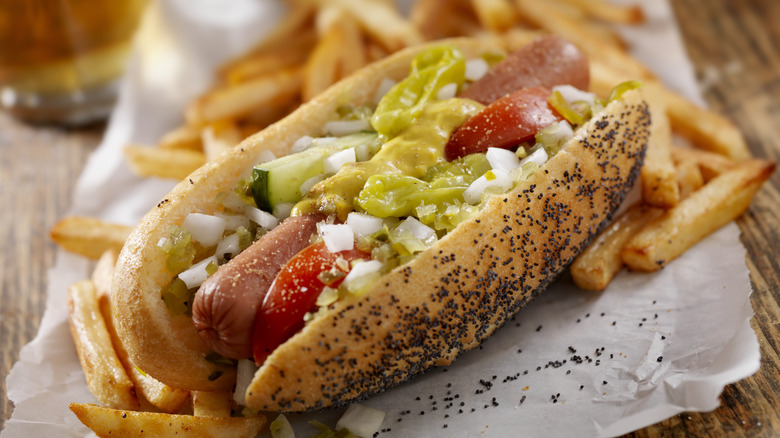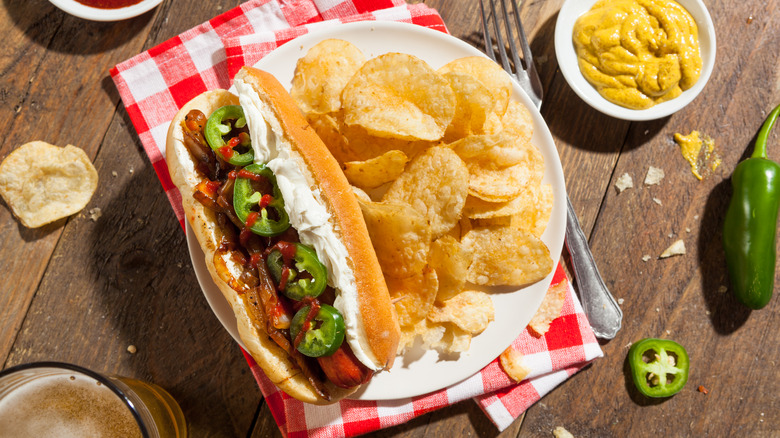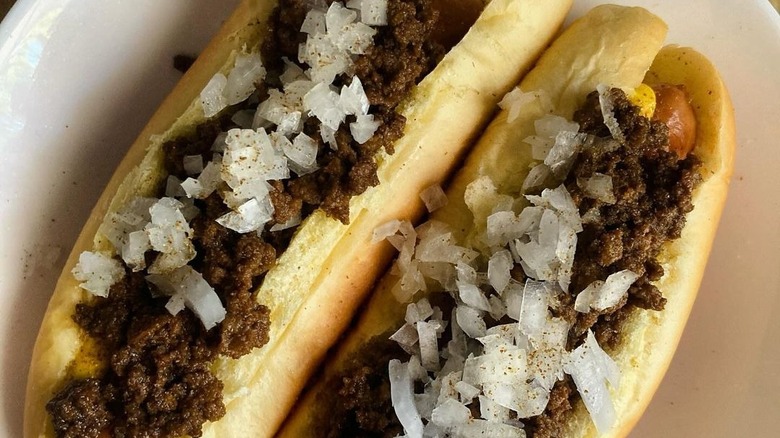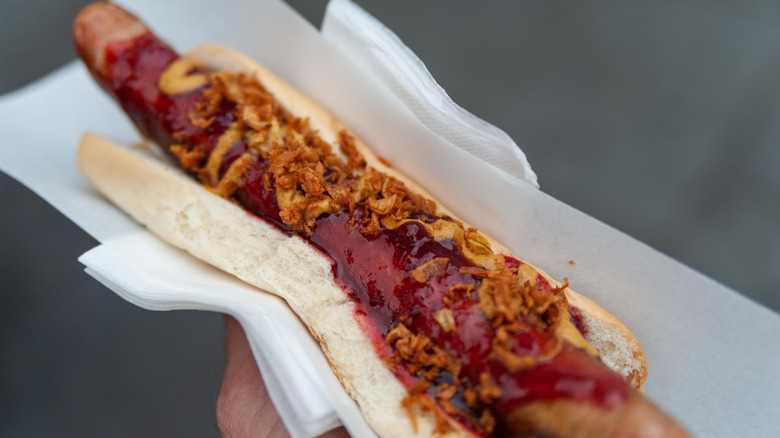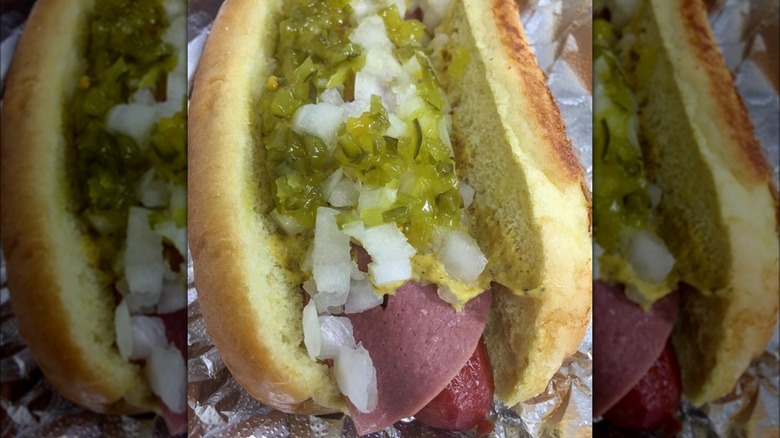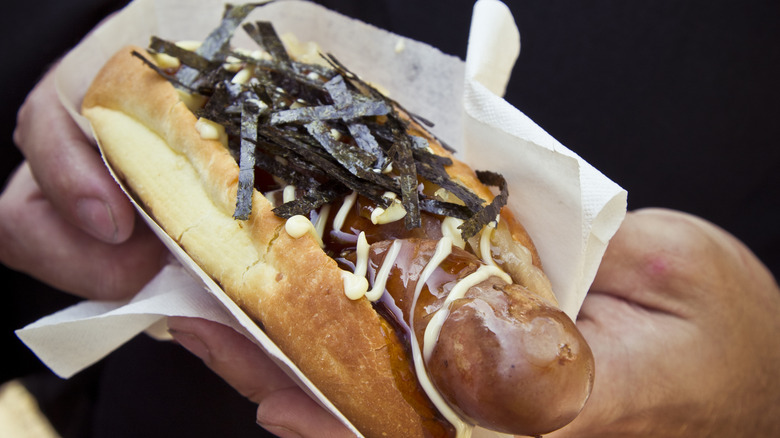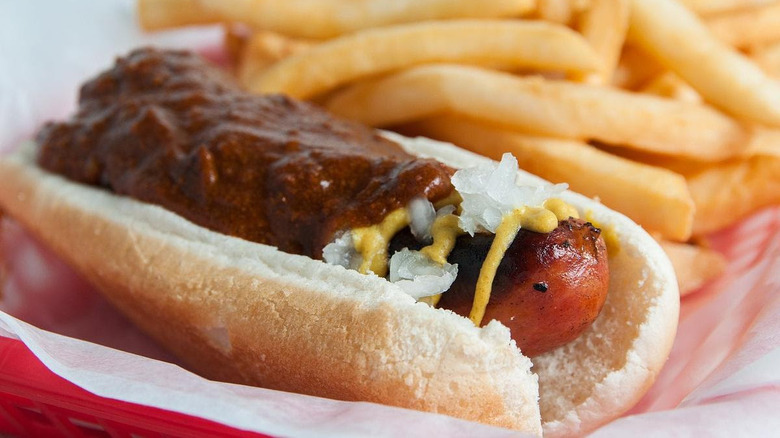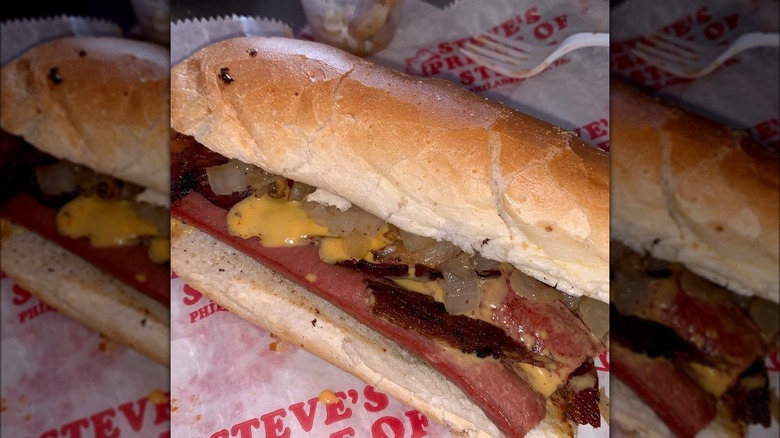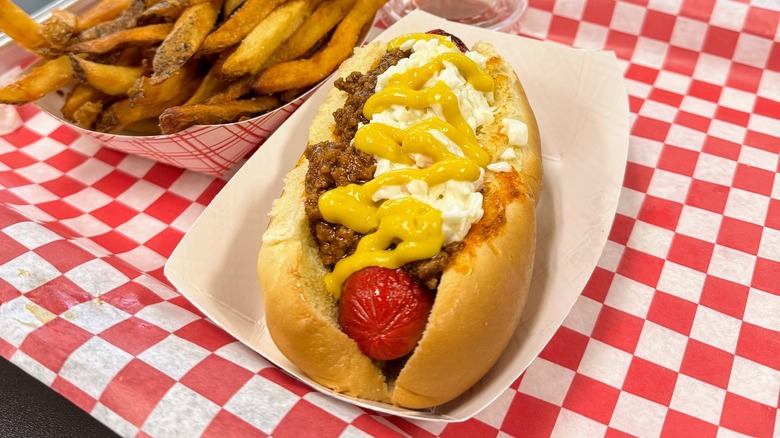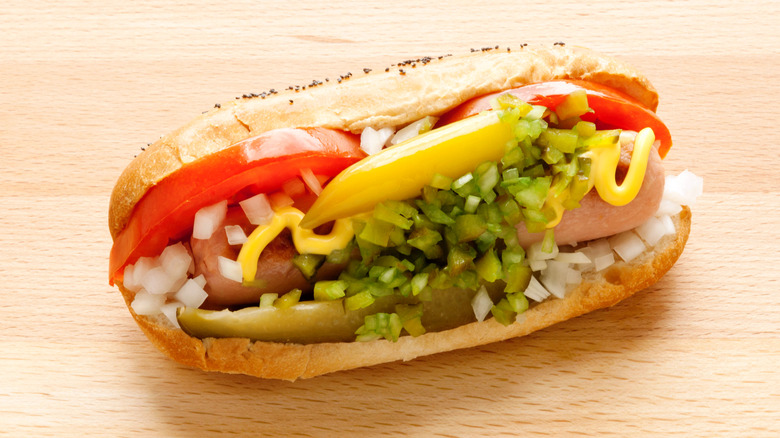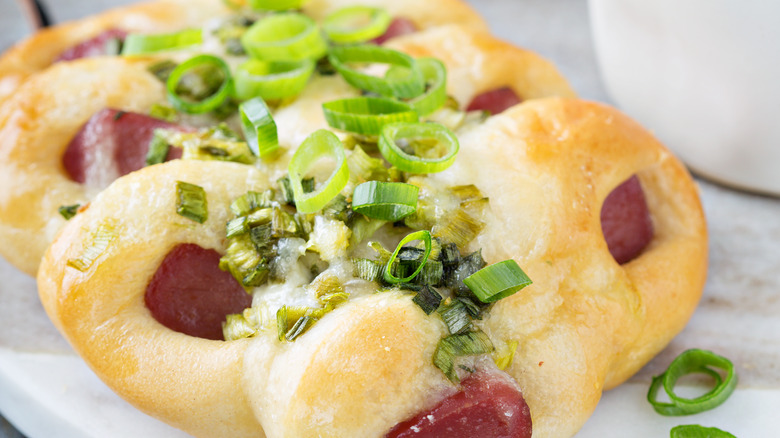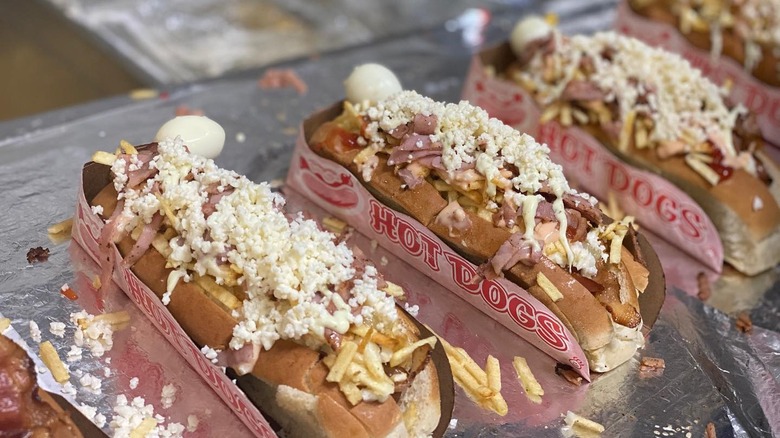Regional Hot Dog Styles You've Probably Never Heard Of
Hot dogs are considered an iconic and quintessentially American food — no day at the ballpark or Independence Day picnic would be complete without them. But like almost everything that defines American culture, hot dogs have their origins in other countries — in this case, Germany and/or Austria, where frankfurters (a specialty of the German town of Frankfurt) and wienerwurst (a sausage specialty of Vienna, Austria) originated. German immigrants to the U.S. first introduced the hot dog as we know it to the U.S. in the 1860s, selling their sausages in buns from pushcarts.
As the popularity of the hot dog spread, communities started putting their own unique spin on the simple combo of a snappy sausage in a bun. A famous example is the Chicago hot dog, an overloaded feast featuring an all-beef hot dog on a poppy seed bun with mustard, relish, onions, tomatoes, a whole pickle spear, sport peppers, and celery salt. Now celebrated as one of Chicago's defining culinary specialties, it was originally devised during the Depression as an affordable full meal on a bun. But Chicago isn't the only region that's made the hot dog its own. Here are some lesser-known and surprising local specialties worth checking out.
Seattle dogs
Over the past few decades, Seattle and the surrounding area has become known as the birthplace of ground-breaking, paradigm-shifting companies such as Amazon, Starbucks, and Microsoft. It seems that questioning conventional wisdom and a willingness to change the rules are as much a part of life in the city as rainy days and coffee. And this goes for Seattle's unusual local hot dog, which features an ingredient that may have the rest of the country scratching its collective head: cream cheese.
This surprising creation was the brainchild of a Seattle bagel vendor, who added hot dogs served on bialy buns with cream cheese to his menu. The odd combo caught on, and soon hot dog street vendors began making similar creations, only with regular hot dog buns instead of bialys. Grilled onions are a standard topping on the Seattle dog, and other toppings, such as sauerkraut, sliced jalapenos, and sriracha sauce are also options. Ketchup, however, is looked down upon. Unlike the products of Seattle's major homegrown corporations, the city's hot dogs have yet to catch on nationally — but fans will warn you not to knock them until you've tried them.
New York System
When exploring the country's many local hot dog specialties, be warned that while many are named after well-known places, these place names can be deceiving: For instance, the New York System — a regional variant of the chili dog — is pretty much unknown in New York City. Instead, it's a hyper-local specialty of Rhode Island. (The name came about when the preparation was first devised in the early 1900s by vendors hoping to capitalize on the popularity of Coney Island hot dogs.)
The New York System originated in the Greek community of Provincetown, Rhode Island, and features a four-inch wiener (preferably cut from a string of links with natural casings) on a sweet, soft steamed bun (which must always come from the Homestead Baking Company in East Providence). On top of this are mustard, celery salt, onions, and a chili-like ground meat sauce. Copycat recipes for the sauce include chili powder and sometimes warm spices such as allspice and nutmeg, suggesting the Greek roots of the recipe. If you want to try the real thing, Olneyville New York System, one of the oldest specialists in these dogs, sells packets of its secret seasoning mix so you can re-create the sauce at home. But for the full New York System experience, you have to assemble your dogs the traditional way — by lining up a row of buns along the length of your non-dominant arm, then using your other arm to add the condiments, hot dogs, and sauce.
Reindeer dogs
Few regional hot dogs embody a sense of place more directly than reindeer dogs, a specialty of (surprise) Alaska. Despite not being native to Alaska (they were introduced from Siberia in 1892 to serve as a cold-tolerant food source), reindeer, a domestic breed of caribou, have become emblematic of Alaska and its rugged landscape. Alaskans have embraced reindeer as a local specialty, and enjoy shocking their out-of-state guests by serving them reindeer jerky and sausage and using the hides and antlers to make decorative items.
It was pretty much inevitable that someone would think to put reindeer in a hot dog. The hot dogs themselves contain a mixture of ground reindeer and pork or beef and are offered up by street vendors in downtown Anchorage. The reindeer lends a slight gamy flavor, a bit like venison, but milder. While you can enjoy a reindeer dog with a range of toppings, from standard ketchup and mustard to non-traditional add-ons such as mac and cheese, for a quintessentially local taste experience, enjoy your reindeer dog with a flavorful and uniquely Alaskan topping: fried onions glazed in Coca-Cola.
Bologna dogs
Local hot dog variations seem to be driven by two main factors: the ingredients available to put in the hot dogs, and who's around to make them. The bologna dog — an all-beef hot dog served with a slice of fried bologna — has its roots in Baltimore's once-thriving Jewish deli community and is thought to have been invented in the 1940s. It was during this time that the deli scene in Baltimore was forced to evolve, as the city's Jewish community started to disperse away from the East Baltimore neighborhoods where the delis had long done business and the rise of supermarkets put price pressure on smaller businesses. One venerable deli, Attman's, for example, pivoted towards sandwiches, hot dogs, and sliced meats to attract lunch customers, and soon adopted — and continues to serve — the bologna dog.
Despite being a nutritionally questionable combo of two of the world's least-healthful meats, the bologna dog continues to be a local favorite, enjoyed without apology. It's still a specialty of Baltimore's delis, and fans say the whole of a bologna dog is more than the sum of its parts. As Baltimore historian Gilbert Sandler explained to the Baltimore Sun (via The New York Times), "Grease from the bologna mixes with the grease from the hot dog, and both find their way into the bread." And if you're in the right mood, this might be exactly what you need.
Japanese-style hot dogs
One reason hot dogs have earned a reputation as an all-American food is because they serve as a kind of culinary melting pot — Americans from all backgrounds have taken the blank canvas provided by the simple sausage-and-bun combo and added flavors from home, and some of these creations have become beloved local specialties.
But the U.S. isn't the only place where creative cooks have put their own spin on the hot dog. Just north, in Canada, Japanese immigrant Noriki Tamura opened a hot dog cart and started adding flavors and toppings that reminded him of home, such as Japanese mayonnaise, shredded dried seaweed, and even yakisoba noodles. While it's unclear what diners back in Japan would make of these creations (hot dogs are a popular street food in Japan, but tend to come with Western toppings), they've become popular enough in North America to have inspired numerous copycat versions.
Half-smokes
Washington, D.C. is known as a global center of power, a place of white-tablecloth state dinners filled with A-listers and high-end restaurants where power brokers gather to make back-room deals over bottles of pricy French wine. But it's also a city with a far more diverse (and accessible) culinary culture, celebrating both the area's many immigrant communities and its longstanding Black community.
A great example of this is the half-smoke, the city's hot dog variant of choice. The term "half-smoke" refers to the sausage itself, a coarse-ground smoked link of pork and beef with a noticeable hit of spice. It's unclear even to D.C. residents what the term "half-smoke" refers to — the meat mixture, the smoking method, or something else entirely. It's thought to have been originally invented as a breakfast sausage, but today, diners buy them from stands and casual take-out restaurants as a lunch or late-night snack. While toppings can include cheese and pickled peppers, the traditional presentation includes generous lashings of mustard, chili, and chopped onions. Pedants may argue that the spicy sausage doesn't technically qualify as a hot dog — but whatever it is, it'll keep you full and happy.
Puerto Rican dogs
If you're a culinary maximalist who can't go to a taco bar without trying every kind of salsa — and who firmly believes there's no such thing as an overdressed burger or sandwich — Puerto Rican hot dogs may be just what you're looking for. They're not so much a dish as an expression of a philosophical conviction: Anything that can go on a hot dog should go on a hot dog. While you can find basic hot dogs with simple toppings such as mustard and relish at Puerto Rico's many modest hot dog stands, for the full Puerto Rican hot dog experience, seek out a place with a range of toppings — and go to town.
So what toppings can you expect on a Puerto Rican hot dog? You can start with the basics — ketchup and mustard — then move on to more extravagant offerings including cheese sauce, sauerkraut, and cooked ground beef fried with sofrito (a cooked seasoning base of chopped onions, peppers, tomatoes, garlic, and herbs). Some cooks offer other toppings as well, such as a relish of caramelized onions, tomato sauce, and sugar. But no matter how many of these you add, don't forget to top off your creation with crispy fried potato sticks for an extra bit of crunch and flavor.
Texas Tommy
The Texas Tommy is yet another regional hot dog with a strong sense of place — even if it's not the place in its name. It was actually invented in Pottstown, Pennsylvania (near Philadelphia) in the 1940s. Its counterintuitive name is believed to have come from a risqué dance popular at the time. The Texas Tommy is a simple, but hearty preparation involving bacon and cheese. In the original version, a strip of bacon was wrapped around the hot dog and the whole thing was deep-fried before being tucked into a toasted bun with melted cheese, but in other versions, a slice of cooked bacon is tucked into a split cooked dog and topped with Cheez Whiz — perhaps a nod to the topping of choice on another local specialty, the Philly cheesesteak.
Today's purveyors of the Texas Tommy, still found in a few places around the Delaware Valley, seem quite aware that their original creation has no real connection to Texas — Johnnie's Dog House and Chicken Shack in Wilmington, Delaware, for instance, offers both the original fried version of the Texas Tommy and the Texas Ranger, whose barbecue sauce garnish is a clear nod to the Lone Star State.
Slaw dogs
Many regional hot dog variants are unapologetically meaty — besides the dog itself, they often come festooned with generous portions of other proteins, such as bacon, chili, and even bologna. The slaw dog, which first emerged in West Virginia in the 1920s and soon became a regional favorite around the Southeast, is a refreshing exception to this trend. While most slaw dogs do come with chili, their defining feature is a big scoop of creamy, finely chopped coleslaw, and some purists prefer to skip the chili altogether and enjoy their dogs with nothing more than a generous topping of coleslaw and maybe a touch of mustard.
While slaw dogs may sound like something devised by a bunch of moms trying to get their kids to eat more vegetables, fans love the textural and temperature contrast between the hot sausage and bun and cold coleslaw. And slaw dog aficionados take them seriously. "The chili and the slaw must be designed to be together, and their taste profiles must be complementary," Stanton Means, a West Virginia food blogger, told Atlanta magazine. "The slaw can be sweet if the chili is spicy, but less spicy chili requires a more subtle flavor in the slaw."
Alligator-style dogs
While you can get hot dogs and sausages made from actual alligator meat, alligator-style dogs are in fact alligator-free. And unlike other hot dog variants closely rooted in specific cities or geographical regions, alligator-style dogs — which are simply hot dogs with a whole pickle spear (the "alligator") tucked into the bun (much like in a Chicago-style hot dog) — make their home not in a single region but in a specific type of locale: baseball stadiums.
While alligator-style dogs are available across the country (provided you ask a vendor who knows what they are), they are especially common in the Cincinnati area, where the pickle spears top hot dogs already slathered in the city's famed (or infamous) cinnamon-and-clove infused chili (A lot of the hate for Cincinnati chili seems to come from the fact that it confuses people — the flavor profile just doesn't track for chili in many diners' minds). It's not clear exactly where or when alligator-style dogs came to be –- but if you'd like some extra crunch and tang to cut the richness of your dog, they're worth checking out.
Chinese hot dog buns
Hot dogs may have a reputation as an all-American food, but in reality, they've become a global treat. While they originated in Germany and gained widespread popularity in the U.S., cooks around the world have embraced them and given them their own local flair. If you visit a bakery in Hong Kong (or a Chinese bakery in the U.S.), you'll see hot dogs on offer, but not in a standard split bun. Instead, they will likely be more like pigs in a blanket, wrapped in a soft, sweet dough and baked. And they will be typically sold — and served — at room temperature.
Chinese hot dog buns can make a great snack or light lunch, but even their fans admit they (like any dish) can be mediocre if not served fresh or made with good-quality ingredients. To get them at their best, hit your local Chinese bakery early — if there are even any left by mid-afternoon, they may have gotten soggy from just lying around. And if you're adventurous and want to make them yourself, use good-quality hot dogs and sear them before wrapping to add some color and texture. If you go to the right bakery, you might encounter an especially pretty variation — hot dog flower buns, made by wrapping whole hot dogs in dough, slicing the wrapped dogs crosswise, and assembling the sliced rounds into flower shapes before baking.
Colombian hot dogs
Another treat for those with hearty appetites and a love of condiments is the Colombian-style hot dog, or perro caliente (the literal Spanish translation for a dog that is hot). It's not for dainty eaters or those trying to avoid drips or spills — if you get a fully loaded Colombian-style dog, a few drips will be almost inevitable. Your order will come with a dizzying range of sauces that practically bury the hot dog itself — garlic mayonnaise, salsa rosada (a pinkish mixture of mayo and ketchup), and pineapple sauce. Topping it all off — and adding a welcome bit of crunch — will be a pile of crushed potato chips. And sometimes, if you find the right vendor, you'll also get a row of three hard-boiled quail eggs. Some variations gild the lily even further, adding shredded mozzarella and coleslaw to the pile of toppings.
If you're looking at this list of ingredients and thinking it sounds like drunk food, you're not wrong. These dogs are a popular late-night snack in Colombia's bigger cities, offering a welcome bit of fortification after a long night of club or bar hopping or dancing. Even better, you can find them in Colombian immigrant enclaves here in the U.S. — or make your own version at home.

